8 Major Ports In Chile
The South American nation of Chile is a developing economy, also ranked as the most socio-economically stable country in Latin America with low levels of corruption and poverty. It holds a significant percentage of the world’s copper reserves which makes copper, the dominant export commodity followed by minerals such as lithium and agricultural produce, mainly fruits.
Chile’s growing tourism sector is also a major driver of economic growth. Facing the Pacific Ocean on its western border, it has over 70 deep seaports and harbours which handle 95% of the country’s foreign trade. Chile also has FTAs with countries like Canada, the US, Mexico, European Union, Japan and China.
1. Port of San Antonio
San Antonio is the premier port of Chile and also the busiest facility on the western South American coastline. It lies just 115 kilometres from the capital Santiago in the central region. It is a naturally well-protected harbour however it experiences swells occasionally. Constructed to accommodate all kinds of maritime cargo, it has facilities for dealing with conventional cargo, bulk, Roro, containerised goods and oil tankers. Approximately 1000 ships frequent the port every year carrying 12,150,000 tonnes of cargo and 775,000 TEUs.
The port dates back to the 17th century and was an important trading post for the Portuguese. It was built by a Portuguese conquistador who constructed a warehouse for storing agricultural goods and seafood which were then transported to Santiago.
Presently, the port comprises four commercial areas covering 496 hectares with a maximum water depth of 11.5 m. It is an intermodal hub, linked with roadways and railways, connecting the capital, the southern hinterland, and Argentina.
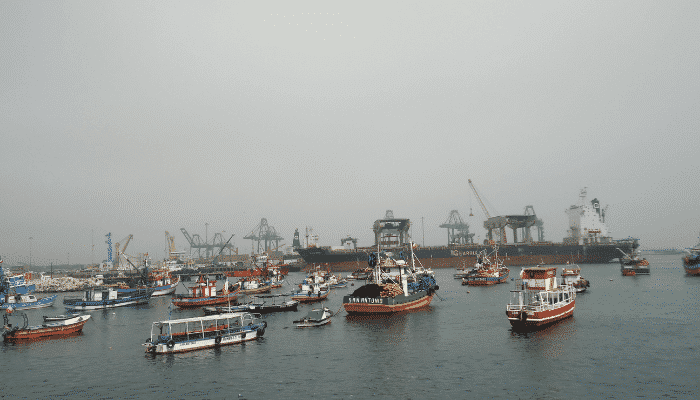
International Container terminal
San Antonio’s container handling facility is one of the largest in South America. Around
10,442,624 tons of cargo passed through the facility in 2020. Employing more than 1000 technicians and engineers, the Molo terminal has a total quay length of 740 m with alongside depth of 11 m. Comprising 30 hectares of covered storage area for containers and bulk, it also incorporates 10,500 sq m of open storage space and 790 reefer plugs.
North Terminal
It has dedicated wharves for loading and unloading Bulk and Break Bulk spanning 250 m with depths of 10.5 m for accommodating ships weighing up to 65,000 DWT. Ships and tankers with an LOA of 190 m and a deadweight of 45,000 tonnes can dock at the Policarpo terminal which deals with oil, petrol etc.
The Multioperado terminal
It is jointly operated by a group of private companies. It has 4 docks for dealing with solid and bulk cargo, 210 reefer connections for containers and 7 hectares of total storage area. 21 shipping companies operate from this terminal. The Vopak terminal has numerous berths for handling liquid bulk.
2. Port of Valparaiso
Valparaiso port also called the ‘ Jewel of the Pacific’ is Chile’s second most important port facility situated in the country’s central region facing the Pacific Ocean. It attained a significant position in the global maritime trade of the 19th century as a stopover port for vessels sailing between the Atlantic and Pacific via the Magellan Strait. However, with the construction of the Panama Canal, it witnessed reduced sea traffic since ships started taking the shorter route.
However, with the Chilean growth of the tourism and shipping sector due to rising exports, the port became one of the busiest facilities since the late 1990s. A cultural centre and the most popular cruise destination, Valparaiso port is a major contributor to the Chilean economy as more than 45 cruise ships frequent the port during the summer months carrying 100,000 tourists. It is also a cargo port that handles 10 million tonnes of conventional cargo and more than 30% of Chile’s international maritime trade through its various terminals. It is also the second-highest container handling facility after the port of San Antonio.
It covers 50 hectares and has facilities for accommodating container goods, liquid and bulk. Exports include copper, fresh fruits, wine etc while major imports include chemical products, vehicles and packaged food.
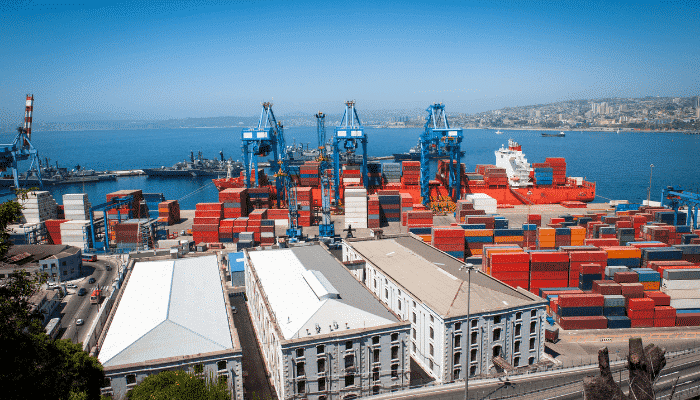
Pacifico Sur terminal
This facility incorporates 190 reefer connections, cold storage facilities, 2 yards for stacking containers, an administrative office, 10 container berths covering 1410 m with alongside depths ranging from 7 to 11.5 m respectively. Port equipment includes 3 shore cranes, 2 mobile cranes and some forklifts, reach stackers and trailers.
Passenger Terminal
As the name suggests, this facility handles cruise ships and comprises the popular Muelle Prat, which is a major passenger berth adjacent to the city’s biggest tourist market comprising the help centre, cafes, souvenir shops, ticket booking offices, and so on. This terminal also houses a resort which offers a beautiful view of the Marina.
3. Port of Arica
Lying on northern Chile’s Pacific shore a few kilometres from the border of Peru, Arica counts among the important Chilean ports. It is crucial for the local economy since it exports the agricultural produce of the Azapa and Rio lluta valleys comprising olives and citrus fruits. It is also a transhipment port for Argentina, Peru, Brazil and functions as a free port for Bolivia. Linked by roadways and railways to all the important cities of Chile, it is the commercial hub of northern Chile.
The airport is also situated close to Arica port, which comprises six wharves, sheltered by a breakwater spanning 1100 metres. The port handles exports of bulk minerals, metals, fishmeal, olives and oil. Major imports include fertilisers, cereals, grains, machine parts, and consumer goods. The port also houses an oil pipeline coming from Bolivia. Approximately 1,093,597 tonnes of cargo and 300 ships visit the port every year.
The port has 2 oil handling facilities, one for loading and the other for discharging with port equipment for handling cargo with a maximum lifting capacity of 100 tonnes.
The inner port has 7 docks covering 180,000 sq m and warehouses spanning 28,000 sq m. This facility can handle 3 million tonnes of cargo.
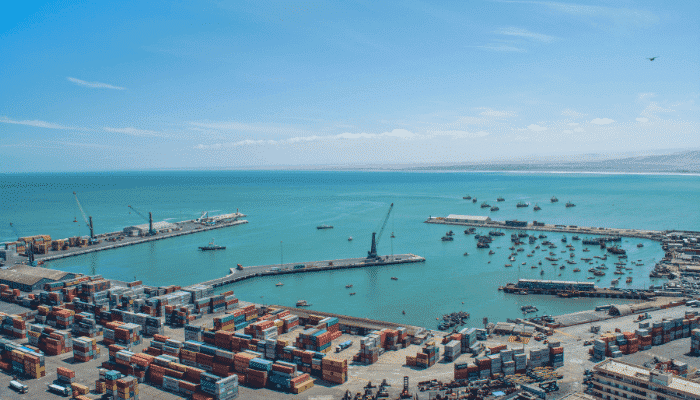
The North port area serves feluccas, schooners and fishing boats. It has a fishing wharf covering 180 m with a depth of 5 m. The north port covers 14,000 sq m and incorporates famous seafood restaurants, cafes, and shops selling fresh fish. 6 warehouses with cold storage facilities are leased to private shipping companies. An area covering 60,000 sq m adjacent to the port is being developed as a commercial centre for attracting new businesses to the north. An industrial Park covering 215,000 sq m is also located just a km from the port.
The Passenger terminal of the port attracts tourists and seafood lovers. The 3 passenger berths covering 2400 sq m, can accommodate cruises and small yachts.
4. Port of Coquimbo
Coquimbo port is located near the Bay of Coquimbo in the central part of the country. It is a well-protected natural harbour, a commercial and trading centre along with being a famous South American port city. In winters the port is used by the country’s naval fleet. An expanding cargo port, varieties of goods such as cement, agricultural commodities, ores, fertilisers and concentrates pass through it. Around 210,000 tonnes of general cargo and 2,550 TEU are handled at Coquimbo annually.
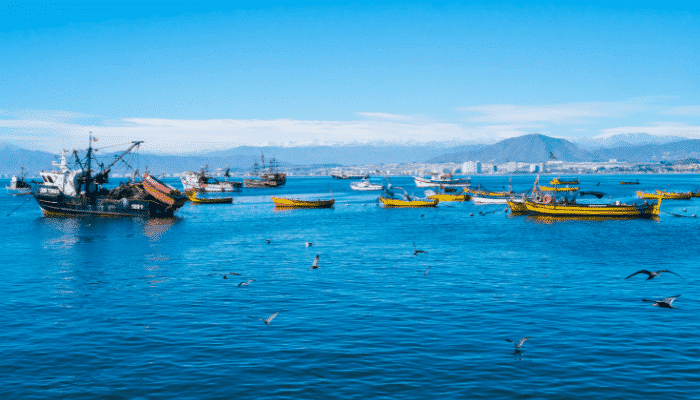
The word Coquimbo translates to the ‘region of still water’ and hence the port was named so because of its serene bay overlooking the port city. It was used by indigenous people before being occupied by Spanish colonists in the 16th century.
Coquimbo port has 2 wharves for handling general cargo with a total length of 380 m and alongside depths of 11 m. One of the berths is dedicated to handling exports of copper, fresh fruits, dried fish, minerals while the other handles shipments of wheat, maize, sugar and industrial goods.
5. Port of Iquique
Iquique port lies in the Tarapacá region, on Chile’s northern Pacific facing coastline. It is an artificial harbour constructed on reclaimed land and has facilities for handling container goods, dry cargo, liquid bulk, breakbulk, roro and passengers. Since it is positioned on an island, it can be expanded, unlike Chile’s other ports whose expansion is restricted due to the growth of their cities. A logistics centre is located close to the port covering 2 hectares including 9 warehouses, a platform, multiple ramps and automated controls, aiding in port operations.
The port has two breakwaters, one spans 470 m and connects the island of Serrano with the mainland while the main breakwater measures 850 m. Iquique port has 7 wharves and two oil terminals for handling petroleum products. The port can accommodate ships weighing up to 50,000 DWT.
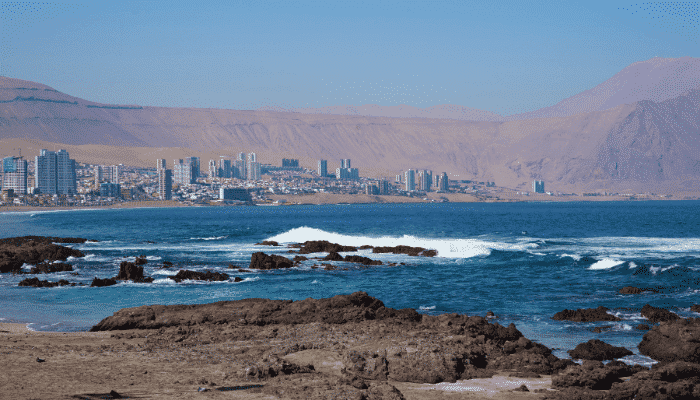
Iquique port covers 20 hectares and handles imports of machine equipment, explosives, sacks, paper, copper concentrates, iron, slag, vegetable oils and general cargo as well as containers. It has a dedicated fishing wharf close to manufacturing units packaging fishmeal, frozen fish and canned seafood. Around 1,360,000 tonnes of cargo and 590 ships frequent the port annually.
6. Port of Lirquen
Lirquen port lies on the southeastern side of the Bay of Concepcion and is an important port of Chile handling imports of container goods, fertilisers, sugar, cereals and general cargo. It exports wood, newsprints, pulp, fishmeal, fruits and lumber and is connected to the copper mines of central chile through railways, hence copper is also a major export commodity. Approximately 2,710,000 tonnes of cargo and 280 ships pass through this port annually.
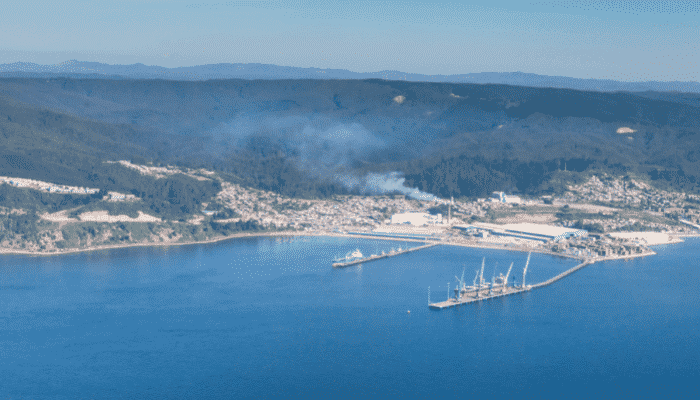
The port covers 490,000 m2 which houses the six berths, stacking areas, workshops, buildings and port offices. The container storage area spans 250,000 m2 while the covered storage space measures 140,000 m2. Lirquen can accommodate the biggest vessels with an LOA of 357 m.
It has two main cargo handling areas. Pier 1 accommodates breakbulk carriers on its four berths that are endowed with a mechanised conveyor belt system for swift and efficient loading and unloading of bulk cargoes. Pier 2 has two designated berths for handling only container goods. Lirquen port has the latest port equipment including 7 mobile cranes, 15 forklifts, 30 trucks and 29 chassis.
7. Port of Punta Arenas
This port facility lies in the southern part of Chile near the Strait of Magellan and handles conventional cargo, container goods and passengers. It is an important transit port for ships operating in the Atlantic and Pacific oceans. It has many wharves, terminals and subsidiary ports such as Puerto Percy, Lenadura, Bahia Gregoria, Caleta Cutter, Laredo etc.
Punta arenas handle 350,000 tonnes of cargo and 13,000 TEU annually.
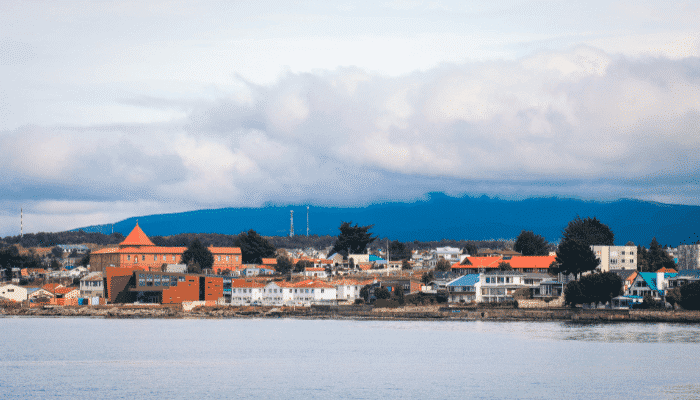
The port has numerous public and private wharves for handling methanol, meat, fish and wool. An LPG terminal is located at Cabo Negro, one of the subsidiary ports which can accommodate oil tankers weighing up to 100,000 DWT, with an LOA of 240 m and a draught of 12 m.
8. Port of Talcahuano
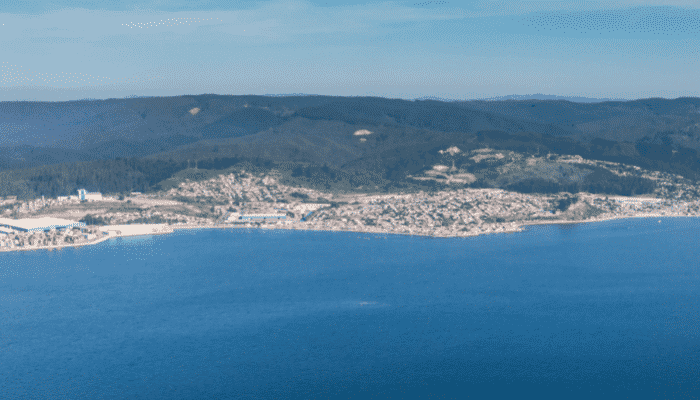
Talcahuano port is situated on the southwestern tip of Concepcion Bay and is a prominent manufacturing and fisheries hub of Chile. It also houses the country’s main naval base however it witnessed massive destruction due to the earthquake which occurred in 2010. Despite this, the port handles considerable amounts of general cargo, bulk and RORO. It is visited by 300 ships every year and can accommodate vessels measuring 180 m with a maximum draft of 10 m.
A naturally well-protected port, it is divided into a cargo handling area and a fishing port. In its northern part are the naval base and the shipyard offering repair and maintenance of fishing vessels and small cargo ships. The cargo handling facility covers 92,000 sq m while the fishing port spans 19,000 sq m. It has 2 warehouses and 33,000 sq m of storage space.
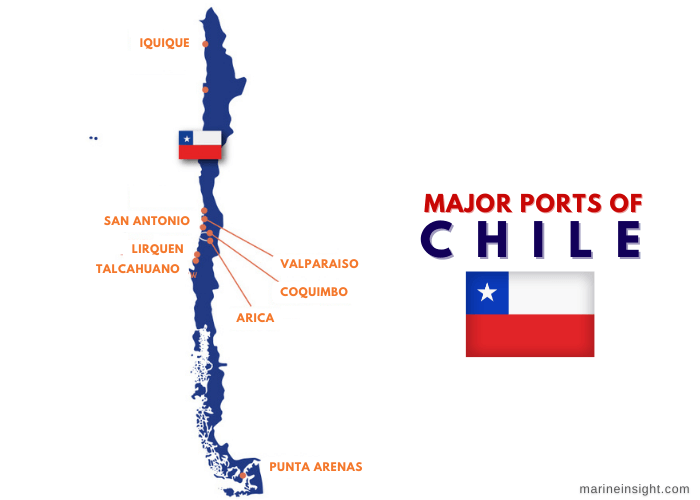
You might also like to read:
- 5 Major Ports of Somalia
- 7 Major Ports in Saudi Arabia
- 6 Major Ports in South America
- 8 Major Ports in Australia
- 2 Major Ports of Lithuania
Do you have info to share with us ? Suggest a correction

About Author
Shilavadra Bhattacharjee is a shipbroker with a background in commercial operations after having sailed onboard as a Third Officer. His interests primarily lie in the energy sector, books and travelling.
Latest Maritime Knowledge Articles You Would Like:
Subscribe To Our Newsletters
By subscribing, you agree to our Privacy Policy and may receive occasional deal communications; you can unsubscribe anytime.















